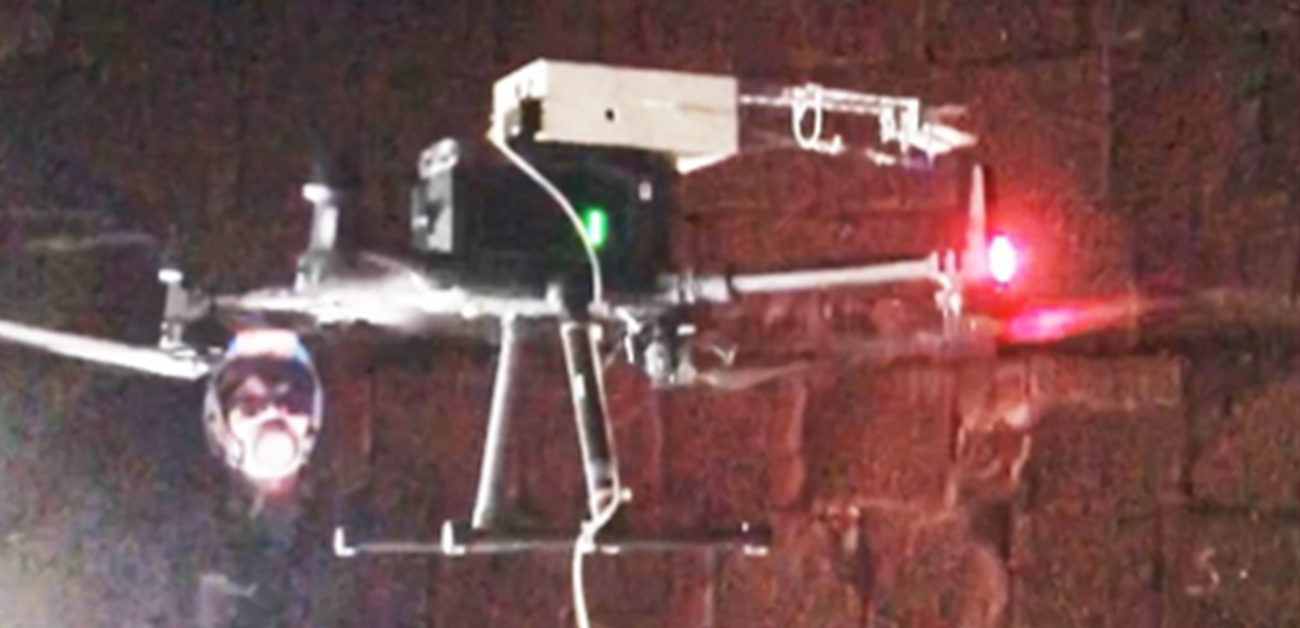
Drone-mounted millimeter-wave radar sees through inner walls of chimneys
Researchers at Osaka University demonstrate ultra-wideband radars using fiber-optic communications technologies
A team of researchers at Osaka University, together with Rediscovery of the wheel Inc., and JFE Shoji Electronics Corporation, has developed an ultra-wideband radar system, which can be mounted on drones. With the cooperation of the Tokuyama Plant of Idemitsu Kosan Co., Ltd., a drone equipped with the radar was flown in a chimney with a height of 150 m during a regular inspection period (Fig. 1). The researchers have succeeded in inspecting the thickness of the lining material, which covers the chimney wall as a protection layer.
“In general, millimeter-wave radars with operation frequencies at 24 GHz, 60 GHz, 77 GHz, and 79 GHz are commonly used mainly for in-vehicle applications. However, due to the limitations of radio-wave frequencies and their bandwidths, the material-penetration capability and resolution are insufficient, and neither of them can be applied to the above diagnosis of the inner wall of the chimney,” explains Assistant Professor Yi.
The researchers have been developing a radar system that utilizes optical communications technologies (Fig. 2). In this system, two different wavelengths of optical signals are first generated in the fiber-optic communications wavelength (1.55 μm) band. When the optical signals are transmitted over an optical fiber cable and applied to a photodiode, which converts the optical signal into the electrical (RF) signal, it is possible to generate radio waves with a frequency corresponding to the wavelength difference between the two optical signals. By precisely controlling the optical wavelength, radio waves can be generated in any band in the range of approximately 1 GHz to 1000 GHz. The position of the reflection point (front or back surface of the object) is known by irradiating the object while changing the frequency of this radio wave and calculating the amplitude phase relationship between the radio wave reflected and returned from the object and the original radio wave.
In order to meet the above-mentioned inspection needs for the inner wall of the chimney, it is necessary to have a technology for transmitting the lining material with a thickness of about 50 mm to 150 mm and measuring the thickness with a resolution on the order of mm. Therefore, through prior experiments, the researchers found that the thickness of the lining material could be measured using the band from 4 GHz to 40 GHz, and tuned the system in Fig. 2 to operate in this frequency band. Fig. 3 is an example of measuring the inner wall of the chimney. Reflection points from the front surface and reflection points from the back surface (metal side) of the lining material are observed, and the distance between the two corresponds to the thickness of the lining material.
This project team is also developing diagnostic technologies for the inner wall surface of the chimney with a 4K camera mounted on the drone, and by integrating it with the technology developed this time, they are promoting the practical application of inspection technologies for chimneys with higher added value. “In addition, it is expected to be applied to the diagnosis of various structures and infrastructure equipment by taking advantage of this radar technology that can easily change the frequency of radio waves from millimeter waves to terahertz waves,” says Professor Nagatsuma, who leads the team.

Fig.1 (a) Appearance of an ultrawide-band millimeter-wave radar mounted on a drone. (b)-(d) Maneuvering the drone inside the chimney and inspecting the inner wall of the chimney while raising the drone. In (d), the chimney opening can be seen above.

Fig.2 Block diagram of the ultrawide-band millimeter-wave radar mounted on the drone. The feature is that the generation of millimeter-wave signals is controlled by utilizing optical communications technologies. Control of millimeter-wave generation and processing of detected signals are performed on the ground. It can handle up to the terahertz-wave band by replacing the parts mounted on the drone.

Fig.3 Example of measurement results. (a) Reflection of radio waves at a certain point. Reflected waves from the front surface and the back surface of the lining material are observed, and the thickness is estimated to be 76 mm from the difference. (b) An example of imaging the lining thickness in the circumferential direction of the chimney.
Related Links
Tadao Nagatsuma (researchmap URL)
EurekAlert!
